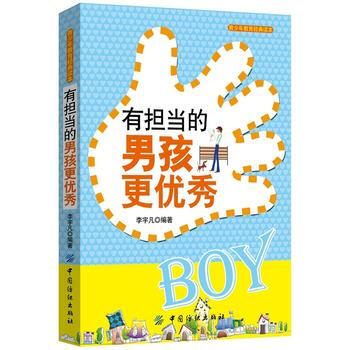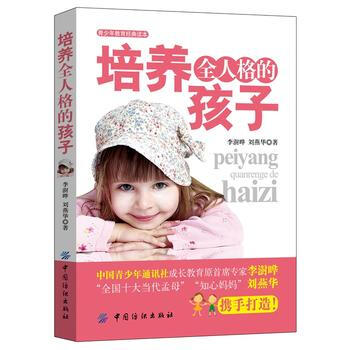具体描述
基本信息
书名:想让孩子亲近你,先让孩子信任你
定价:29.80元
作者:潘鸿生
出版社:北京工业大学出版社
出版日期:2016-12-01
ISBN:9787563949632
字数:
页码:
版次:1
装帧:平装-胶订
开本:16开
商品重量:0.4kg
编辑推荐
很多家长抱怨孩子与自己不亲近了,这是因为父母和孩子之间的沟通出了问题。其实让孩子亲近你也是有秘诀的,你的一言一行,让孩子感受到你是可以信任与接近的人,孩子自然会愿意亲近你。
我们要把自己和孩子放在同一个坐标上,不能一个俯视一个仰视,要相互平视,*好的尊重方式莫过于:用孩子的视角来观察他,用孩子的思想来理解他,同时更要尊重孩子的小小的心灵,这才是真正把孩子当做一个人来看的基础。
内容提要
很多家长都希望成为孩子的知己,成为陪伴孩子一起成长的伙伴。但是在教育孩子的时候,会发现,很多孩子会抵触情绪,不愿意让家长亲近自己。为此,很多家长苦恼不已。其实,每个孩子也都会有自己的想法,他们希望得到的伙伴不是在生活中对自己指手画脚、高高在上的人,而是一个自己信任、也信任自己,能让自己打开心扉讲出内心烦恼的人。本书结合当下热点的案例,及中外一些名家的理论,让每一位家长都学习到,如何亲近孩子,如何成为孩子知心的伙伴。
目录
章 把尊重孩子作为家庭教育的基础
尊重孩子是一切教育的前提3
蹲下来是尊重孩子的另一种姿态7
尊重孩子的隐私,赢得孩子的信赖13
尊重孩子就要给足孩子面子18
尊重孩子的人格,把孩子当作独立的人22
不要操之过急,尊重孩子的成长规律28
尊重孩子的选择,给孩子做主的权利34
第二章 用陪伴赢得孩子的心
陪伴是好的教育43
陪孩子一起玩耍46
多陪孩子聊聊天51
世界那么大,带孩子去看看57
给孩子更多的爱和关注62
拥抱是给孩子好的礼物66
再忙再累也要陪陪孩子73
第三章 用欣赏的眼光看待孩子
善于发现孩子的优点83
赞美让孩子更90
让孩子发现自己与众不同95
孩子因赏识而进步101
用鼓励陪伴孩子成长105
赏识让孩子扬起自信的风帆110
第四章 用信任帮助孩子健康成长
信任是孩子成长的力量117
学会向孩子道歉122
不要让孩子和别人做比较127
对孩子说到做到,信守承诺131
放下架子,与孩子平等相处136
正确看待孩子交异性朋友140
第五章 父母要与孩子共同成长
父母以身作则,为孩子树立榜样147
管不住情绪,孩子就将离你远去151
不要将未完成的梦想强加在孩子身上157
提升自身素质,教育孩子的同时完善自己162
父母并不完美,何必苛求孩子十全十美166
不要给孩子设定过高的期望值169
第六章 给孩子自由成长的空间
孩子需要体验生活的机会177
让孩子尝试他想做的事181
让孩子自己处理问题184
给孩子承担责任的机会190
给孩子尽情玩耍的自由195
别把孩子的分数看得那么重要200
给孩子真正自由的空间和时间205
第七章 与孩子建立良好的亲子关系
孩子的话,父母是否真的听懂了213
站在孩子的角度看问题218
打骂教育不出好孩子223
重视与孩子的非语言沟通225
父母越唠叨,孩子越不听话230
与孩子多用协商的语气说话233
让孩子心甘情愿地接受父母的批评238
第八章 正面教育让孩子的心灵更强大
温暖的家是孩子心灵好的土壤245
对孩子提出的各种问题要有足够的耐心249
感恩让孩子的生命更充实254
鼓励孩子,与孩子一起面对挫折259
有了宽容,更容易赢得孩子的信任265
从溺爱孩子的旋涡中摆脱出来269
作者介绍
潘鸿生,畅销书作者、图书策划人、心灵成长导师,对于青少年教育具有自己独到的见解。近年来致力于家庭教育、青少年心理健康及自我提升等相关领域的研究和著述工作。其作品以故事见长,说理精辟,实用性强,为家长和孩子之间架起了一座沟通、理解、亲近的桥梁,得到读者的一致好评和支持。曾策划、撰写过《好家风成就好孩子》、《好父母给孩子好的教育》、《做人如水的哲学》、《听南怀瑾大师讲庄子》等图书。
文摘
序言
《 parent-child communication and connection: building trust and fostering intimacy 》 Introduction In the intricate tapestry of family life, the bond between parents and children forms the most vital thread. This bond, however, is not an innate given; it's a delicate ecosystem nurtured through consistent effort, understanding, and, most importantly, trust. "parent-child communication and connection: building trust and fostering intimacy" delves into the profound importance of cultivating a strong, trusting relationship with your child, not as a means to an end, but as the very foundation upon which healthy development and lasting familial harmony are built. This book is a compass for parents seeking to navigate the often-complex waters of raising children, offering practical insights and actionable strategies to foster genuine connection and an unwavering sense of security in their little ones. The Unseen Pillars of a Strong Bond At its core, this book argues that a child's willingness to embrace their parents, to confide in them, and to seek their guidance stems directly from a bedrock of trust. This trust is not a sudden revelation but a gradual accumulation of countless small interactions, of consistent reliability, and of being truly seen and heard. It's the quiet reassurance a child feels when they know their needs will be met, their feelings validated, and their individuality respected. Without this foundational trust, parental efforts, however well-intentioned, can feel like building on sand, easily eroded by the storms of childhood and adolescence. Understanding the Child's World: A Crucial First Step To build trust, parents must first endeavor to understand the world from their child's perspective. This involves stepping outside their own adult realities and immersing themselves in the unique emotional landscape of childhood. This means recognizing that a scraped knee can feel like a monumental tragedy to a young child, that a minor social slight can feel like the end of the world to a teenager, and that their worries, however seemingly small to us, are very real and impactful to them. The book explores the different developmental stages of childhood and adolescence, highlighting the evolving needs and communication styles inherent in each. It emphasizes the importance of observing a child's behavior not just as actions, but as forms of communication. A tantrum, for instance, is not merely defiance but often an unfiltered expression of unmet needs, overwhelming emotions, or a cry for attention. A withdrawal into silence might signal hurt, confusion, or a sense of not being understood. Learning to decipher these non-verbal cues is a powerful tool in building trust, as it demonstrates a parent's attentiveness and willingness to engage with their child's inner world. The Art of Active Listening: More Than Just Hearing Words A cornerstone of building trust is the practice of active listening. This is not simply waiting for one's turn to speak or passively absorbing sounds. Active listening is a conscious, engaged process that involves fully concentrating on, understanding, responding to, and remembering what is being said, both verbally and non-verbally. This book dedicates significant attention to the nuances of active listening. It provides practical techniques such as: Giving Undivided Attention: Putting away distractions like phones, making eye contact, and turning one's body towards the child signals that they are the sole focus. Reflecting and Paraphrasing: Repeating back what the child has said in one's own words ("So, if I understand correctly, you're feeling frustrated because...") not only confirms understanding but also helps the child clarify their own thoughts and feelings. Validating Emotions: Acknowledging and accepting the child's feelings, even if they seem irrational or disproportionate to the parent, is crucial. Phrases like "I can see you're really upset about this" or "It's understandable that you would feel disappointed" convey empathy and acceptance, fostering a safe space for emotional expression. Asking Open-Ended Questions: Instead of questions that elicit a simple "yes" or "no," open-ended questions encourage elaboration and deeper sharing. "What happened next?" or "How did that make you feel?" invite more detailed responses. Avoiding Interruption and Judgment: Allowing the child to finish their thoughts without premature conclusions or immediate criticism is paramount. Judgment can shut down communication instantly, breeding resentment and secrecy. The Power of Empathy: Walking in Their Shoes Empathy is the ability to understand and share the feelings of another. For parents, cultivating empathy towards their children means making a genuine effort to see the world through their eyes, to feel their joys and sorrows, and to understand their unique challenges. This isn't about condoning misbehavior, but about understanding the emotions that drive it. The book explores how empathy can be demonstrated through: Shared Experiences: Participating in activities your child enjoys, even if they are not your personal preference, shows you value their interests and are willing to connect on their level. Emotional Mirroring: Reflecting a child's emotional state can help them feel understood. If a child is excited, sharing in that excitement with a similar energy level can strengthen the bond. If they are sad, offering gentle comfort and mirroring their subdued mood can convey solidarity. Perspective-Taking: When a child is struggling, helping them articulate their feelings and the reasons behind them, and then offering a gentle, understanding perspective, can be incredibly powerful. Consistency and Reliability: The Bedrock of Security Children thrive on predictability and consistency. When parents consistently follow through on their promises, maintain reasonable boundaries, and respond to their child's needs in a predictable manner, they build a profound sense of security. This reliability is the silent language of trust. The book highlights the importance of: Following Through on Promises: Whether it's a promised outing or a simple gesture of comfort, keeping promises, big or small, builds credibility. Establishing Clear and Consistent Boundaries: Children need to know what is expected of them and what the consequences are for breaking rules. Consistent enforcement, rather than arbitrary or emotional reactions, fosters understanding and respect for boundaries. Predictable Routines: Established routines for meals, bedtime, and daily activities provide a sense of order and security, reducing anxiety and making children feel safe and cared for. Emotional Stability: Parents who can manage their own emotions and respond to their children's needs with relative calm and consistency offer a stable anchor in a child's life. Fostering Open Communication: Creating a Safe Haven for Dialogue The ultimate goal of building trust is to create an environment where open, honest communication can flourish. This means creating a safe space where children feel comfortable expressing their thoughts, feelings, fears, and even their mistakes, without fear of harsh judgment, ridicule, or dismissal. This book offers strategies for cultivating such an environment: Initiating Conversations: Parents should not wait for children to initiate. Regularly checking in, asking about their day, their friends, their interests, and their concerns, even for a few minutes each day, can make a significant difference. Creating Opportunities for Dialogue: Beyond formal conversations, utilize everyday moments – car rides, meal times, walks – as opportunities for informal chats. These relaxed settings can often lead to more genuine sharing. Responding with Reassurance, Not Reprimand: When a child shares a mistake or a difficult experience, the initial response should be one of understanding and reassurance, not immediate scolding. "Thank you for telling me" or "It takes courage to share this" can be far more effective than "I told you so." Modeling Open Communication: Parents who are open and honest about their own feelings and experiences, within appropriate boundaries, model healthy communication for their children. Respecting Privacy: As children grow, respecting their need for privacy, while still maintaining an open door for communication, is crucial. Beyond Simple Obedience: The Gifts of True Connection When children trust their parents, the benefits extend far beyond mere compliance. They are more likely to: Share their triumphs and their struggles: They will confide in you about their successes and seek your comfort and guidance when they face challenges. Seek your advice: They will value your opinion and consult you when making decisions. Be open to your guidance: They will be more receptive to your advice and less likely to engage in risky behaviors out of rebellion. Develop stronger self-esteem and resilience: Knowing they have a secure base of support allows them to explore the world with greater confidence and bounce back from setbacks. Build healthy relationships in the future: The patterns of trust and communication learned in the family environment often extend to their relationships outside the home. Conclusion "parent-child communication and connection: building trust and fostering intimacy" is not a quick fix or a set of parenting hacks. It is a comprehensive guide to cultivating a profound and enduring relationship with your child, grounded in the essential element of trust. By understanding their world, actively listening, practicing empathy, remaining consistent, and fostering open communication, parents can build a bridge to their child's heart, creating a secure and loving connection that will serve as a guiding light throughout their lives. This journey of building trust is an ongoing one, filled with moments of both challenge and immense reward, ultimately leading to a family where love, understanding, and a deep, unwavering bond are not just aspirations, but a lived reality.






















